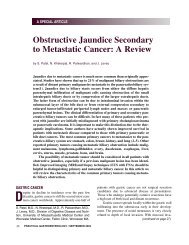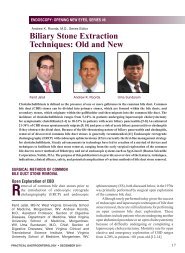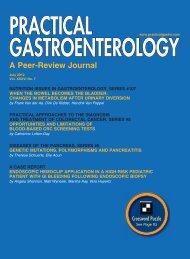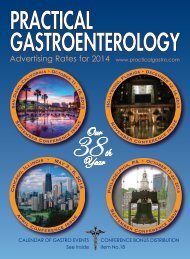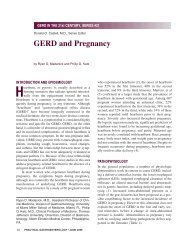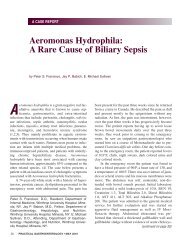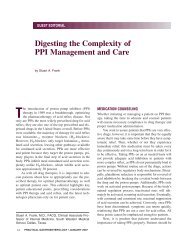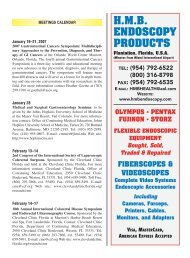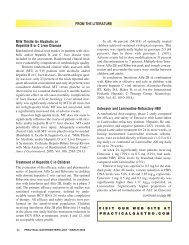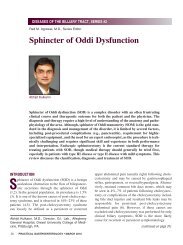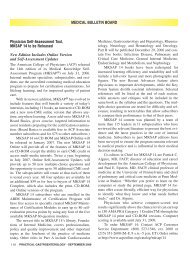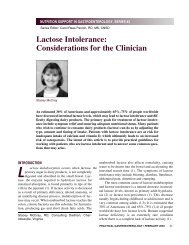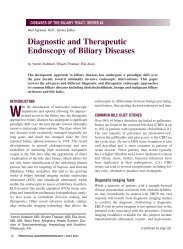Diagnosis of GERD - Practical Gastroenterology
Diagnosis of GERD - Practical Gastroenterology
Diagnosis of GERD - Practical Gastroenterology
You also want an ePaper? Increase the reach of your titles
YUMPU automatically turns print PDFs into web optimized ePapers that Google loves.
<strong>GERD</strong> IN THE 21st CENTURY, SERIES #10<br />
Donald O. Castell, M.D., Series Editor<br />
<strong>Diagnosis</strong> <strong>of</strong> <strong>GERD</strong>:<br />
Ambulatory pH Monitoring<br />
by Amine Hila and Donald O. Castell<br />
Gastroesophageal reflux disease (<strong>GERD</strong>) is a common condition. Its diagnosis is not<br />
always straightforward. 24-hour esophageal pH monitoring is considered the gold standard<br />
for the diagnosis <strong>of</strong> acid <strong>GERD</strong>. Standard pH testing involves the placement <strong>of</strong> a<br />
pH probe through the nares into the esophagus or attaching a small transmitter assembly<br />
directly onto the mucosa, this allows the identification <strong>of</strong> acid refluxate into the<br />
esophagus. In analyzing the tracings resulting from ambulatory esophageal pH monitoring,<br />
acid is traditionally detected by the percent time pH drops below 4, both in the<br />
upright and recumbent position. It is also important to include the assessment <strong>of</strong> symptom<br />
association with reflux in the interpretation <strong>of</strong> prolonged esophageal pH studies.<br />
Currently, with the wide use <strong>of</strong> empiric trials <strong>of</strong> <strong>GERD</strong> medical therapy, 24-hour<br />
esophageal pH monitoring has its main indication in assessing patients with poor response<br />
to <strong>GERD</strong> therapy and those in whom an anti-reflux surgical procedure is contemplated.<br />
INTRODUCTION<br />
<strong>GERD</strong> describes the clinical manifestations <strong>of</strong> the<br />
pathological movement <strong>of</strong> acid gastric contents<br />
into the esophagus. The classic symptoms <strong>of</strong><br />
<strong>GERD</strong>, heartburn and acid regurgitation, are common<br />
in the general population. It is estimated that up to<br />
11% <strong>of</strong> the US population experience heartburn daily<br />
and 30% every 3 days (1). The total cost <strong>of</strong> caring for<br />
patients with moderate to severe <strong>GERD</strong> is between<br />
$2,100 and $4,574 per patient per year, and the drugs<br />
Amine Hila, M.D., Department <strong>of</strong> <strong>Gastroenterology</strong><br />
and Hepatology, Medical University <strong>of</strong> South Carolina,<br />
Charleston, South Carolina. Donald O. Castell, M.D.,<br />
Department <strong>of</strong> <strong>Gastroenterology</strong> and Hepatology,<br />
Medical University <strong>of</strong> South Carolina, Charleston,<br />
South Carolina.<br />
used to treat <strong>GERD</strong> rank among the highest in sales<br />
among prescription medications (2,3).<br />
The diagnosis <strong>of</strong> <strong>GERD</strong> is not always straightforward<br />
because <strong>of</strong> the wide range <strong>of</strong> typical, atypical,<br />
and extraesophageal symptoms in patients. A number<br />
<strong>of</strong> tests have been developed to help the physician<br />
identify patients with <strong>GERD</strong>: barium swallow, upper<br />
gastrointestinal endoscopy, esophageal acid perfusion,<br />
and ambulatory esophageal pH monitoring.<br />
Prolonged ambulatory monitoring <strong>of</strong> esophageal<br />
pH is the most reliable method <strong>of</strong> diagnosing <strong>GERD</strong>. In<br />
fact, it allows the measurement <strong>of</strong> the basic pathophysiologic<br />
problem <strong>of</strong> <strong>GERD</strong>, namely the exposure time <strong>of</strong><br />
the esophagus to excessive acid refluxate. This concept<br />
<strong>of</strong> recording GER over a prolonged interval, by placing<br />
a small pH sensitive electrode in the distal esophagus,<br />
(continued on page 36)<br />
34<br />
PRACTICAL GASTROENTEROLOGY • FEBRUARY 2005
<strong>Diagnosis</strong> <strong>of</strong> <strong>GERD</strong><br />
<strong>GERD</strong> IN THE 21st CENTURY, SERIES #10<br />
(continued from page 34)<br />
Table 1<br />
Comparison between the transnasal catheter and the wireless probe.<br />
Transnasal Probe<br />
Wireless Transmitter<br />
20 yr data/experience Many unknowns (more GER)<br />
Catheter limits activity<br />
No catheter<br />
Throat irritation<br />
Bolus effect/chest pain<br />
24 hr data 48 hr data<br />
Accurate placement<br />
Placement variable (where is LES?)<br />
Multiple electrodes easy<br />
Multiple electrodes difficult & costly<br />
Easy passage<br />
Nose bleed (nasal placement)<br />
Stop PPI (endoscopic placement)<br />
Detects acid and non-acid GER (with MII) Detects acid GER only<br />
was first reported by Spencer in 1969 (4). In 1974, Johnson<br />
and DeMeester provided a more extensive evaluation<br />
<strong>of</strong> this technique and expanded its applications (5).<br />
However, these earlier studies were not ambulatory. In<br />
fact, ambulatory esophageal pH monitoring was first<br />
described in 1980 (6). Since then, the technique has<br />
rapidly gained popularity. Light-weight portable data<br />
recorders are available, allowing the patients to be monitored<br />
in their home or work environment.<br />
TECHNIQUE OF AMBULATORY PH MONITORING<br />
There are several types <strong>of</strong> small pH electrodes available<br />
for intraesophageal monitoring. These include<br />
monocrystalline antimony electrodes, combined glass<br />
electrodes, or ion-sensitive field effect transistor<br />
(ISFET) electrodes. The ideal pH probe should be<br />
small so it can be easily passed through the nose into<br />
the esophagus, and it should be firm so that it remains<br />
in a certain position for the entire study. The number <strong>of</strong><br />
electrodes in the pH probe is variable. Single electrode<br />
probes contain only one pH electrode located at the<br />
distal end <strong>of</strong> the catheter. Dual, triple and 4 electrode<br />
probes are available, with standard spacing <strong>of</strong> 5, 10 or<br />
15 cm between electrodes. These different configurations<br />
allow simultaneous gastric, intraesophageal or<br />
even pharyngeal pH recording, as needed. The most<br />
common configuration includes 2 electrodes 15 cm<br />
apart. This allows 2 types <strong>of</strong> monitoring depending on<br />
probe positioning: either simultaneous gastric and distal<br />
esophageal monitoring where the proximal electrode<br />
is 5 cm above the lower esophageal sphincter<br />
(LES), and the distal one in the<br />
stomach; or distal and proximal<br />
esophageal monitoring with the<br />
electrodes 5 and 20 cm above<br />
the LES.<br />
Recently, a new wireless<br />
esopahgeal pH recording device<br />
was introduced. It consists <strong>of</strong> a<br />
pH-sensitive capsule that is<br />
attached to the esophageal<br />
mucosa. Data are sent from the<br />
capsule to a receiver/data logger<br />
by means <strong>of</strong> radio transmission.<br />
This probe does not require a<br />
transnasal catheter, thus <strong>of</strong>fering a possible comfort<br />
advantage. However, the wireless pH capsule must be<br />
placed endoscopically or blindly through the mouth,<br />
which may be a major drawback. Also, the lack <strong>of</strong> precision<br />
when placing this probe relative to its location in<br />
relation to the LES could induce interpretation errors in<br />
the real amount <strong>of</strong> esophageal acid exposure. Table 1<br />
provides a comparison between the transnasal catheter<br />
and the wireless probe.<br />
Standard esophageal pH monitoring involves the<br />
placement <strong>of</strong> a thin (2 mm diameter) pH probe through<br />
the nares, with the distal esophageal electrode placed 5<br />
cm above the manometrically determined LES location.<br />
The normal values for distal esophageal acid<br />
exposure have been defined using an electrode 5 cm<br />
above the manometrically defined proximal border <strong>of</strong><br />
the LES, thus the accuracy <strong>of</strong> the placement is very<br />
important. After it is placed, the probe is connected to<br />
a small light weight data logger worn on a waist band<br />
or shoulder strap. There are different types <strong>of</strong> commercially<br />
available data loggers, but all contain one or<br />
more event markers that allow the patient to indicate<br />
when symptoms occur, when they are eating, and<br />
when they are in a recumbent position. Patients are<br />
also usually required to enter this data on a diary.<br />
After the probe is placed and connected, the<br />
patient is usually monitored for approximately 24<br />
hours, <strong>of</strong>ten 48 hours using the wireless capsule.<br />
Patients are encouraged to eat, drink and go about their<br />
daily activity as close as possible to their usual routine.<br />
They are also encouraged to consume meals that usu-<br />
(continued on page 38)<br />
36<br />
PRACTICAL GASTROENTEROLOGY • FEBRUARY 2005
<strong>Diagnosis</strong> <strong>of</strong> <strong>GERD</strong><br />
<strong>GERD</strong> IN THE 21st CENTURY, SERIES #10<br />
(continued from page 36)<br />
ally produce their <strong>GERD</strong> symptoms. Unless the goal<br />
<strong>of</strong> the study is to assess response <strong>of</strong> GER to anti-secretory<br />
therapy, all medications that affect the pH <strong>of</strong> the<br />
stomach or the motility <strong>of</strong> the foregut should be<br />
stopped before the study.<br />
The 24-hour pH monitoring yields a high sensitivity<br />
as a diagnostic test (7,8). A 24-hour pH monitoring<br />
allows study <strong>of</strong> circadian patterns <strong>of</strong> reflux by including<br />
a nightime or recumbent period. It also allows<br />
monitoring the effects <strong>of</strong> physiological activity.<br />
Although a 24-hour recording period is standard, we<br />
have shown that a shorter period yields good results,<br />
especially if it includes the recumbent period (9).<br />
Thus, a 16-hour study, from 4 P.M. to 8 A.M., has a sensitivity<br />
<strong>of</strong> 97% and a specificity <strong>of</strong> 95% compared to a<br />
24-hour study period, and would allow patients to have<br />
the probe placed late on the first day and removed<br />
early on the second day, potentially minimizing the<br />
possible work time loss. The same study showed that a<br />
shorter 12-hour period, from 4 pm to 4 am, has a sensitivity<br />
<strong>of</strong> 93% and a specificity <strong>of</strong> 92% compared to a<br />
24-hour study period, and thus it is reasonable to<br />
advise the rare patient unable to sleep because <strong>of</strong> the<br />
pH probe, to remove it at 4 am, and thus get a few<br />
hours <strong>of</strong> sleep.<br />
INTERPRETATION OF AMBULATORY<br />
pH MONITORING<br />
1. Reflux Criteria<br />
Johnson and DeMeester defined reflux by a fall in<br />
intraesophageal pH to less than 4 with the episode persisting<br />
until the pH returned to greater than 4 (5). This<br />
threshold <strong>of</strong> pH 4.<br />
C. Initial studies revealed a good association<br />
between symptoms <strong>of</strong> <strong>GERD</strong> and intraesophageal<br />
pH
<strong>Diagnosis</strong> <strong>of</strong> <strong>GERD</strong><br />
<strong>GERD</strong> IN THE 21st CENTURY, SERIES #10<br />
(continued from page 38)<br />
Figure 1: Abnormal upright reflux with normal recumbent<br />
reflux (shaded area).<br />
Figure 4: Three hour segment <strong>of</strong> a prolonged distal<br />
esophageal recording demonstrating the typical pattern <strong>of</strong><br />
upright reflux with multiple episodes <strong>of</strong> short duration.<br />
Figure 2: Recumbent reflux (shaded area) with normal<br />
upright reflux.<br />
Figure 5: Three hour segment <strong>of</strong> a prolonged distal<br />
esophageal recording demonstrating the typical pattern <strong>of</strong><br />
recumbent reflux with a prolonged episode <strong>of</strong> acid exposure<br />
due to lack <strong>of</strong> effective clearing mechanisms while sleeping.<br />
Figure 3: Abnormal reflux in both the upright and recumbent<br />
(shaded area) positions.<br />
sure (Figure 3). Different authors (8,15) found that<br />
patients with combined reflux or patients with supine<br />
reflux alone demonstrated greater acid exposure and<br />
more severe esophagitis than did patients with upright<br />
reflux alone. In upright refluxers, the predominant<br />
mechanism <strong>of</strong> reflux is an increased frequency <strong>of</strong> transient<br />
LES relaxations with relatively preserved acid<br />
clearance from the distal esophagus (16). In patients<br />
with supine reflux, the major abnormality is a marked<br />
impairment in acid clearance (17), resulting in prolonged<br />
reflux episodes from the distal esophagus due to<br />
a combination <strong>of</strong> factors such as elimination <strong>of</strong> gravity,<br />
sleep, and decreased salivary secretion and swallowing.<br />
Combined refluxers probably exhibit both abnormalities<br />
PRACTICAL GASTROENTEROLOGY • FEBRUARY 2005 45
<strong>Diagnosis</strong> <strong>of</strong> <strong>GERD</strong><br />
<strong>GERD</strong> IN THE 21st CENTURY, SERIES #10<br />
Figure 6: A segment from the upright portion <strong>of</strong> a 24-hour<br />
esophageal pH recording demonstrating positive symptom<br />
association for both regurgitation and chest pain.<br />
and is at least as important as the amount <strong>of</strong><br />
esophageal acid exposure. Symptom-GER association<br />
may be particularly important in patients with atypical<br />
or extraesophageal symptoms.<br />
Based on the patient’s diary, and confirmed by the<br />
event marker, each symptom reported by the patient<br />
can be evaluated for a temporal relationship with a fall<br />
in esophageal pH to < 4. In our laboratory, the timing<br />
for a positive symptom association with reflux requires<br />
that the reflux episode occurs within a time window <strong>of</strong><br />
5 minutes before the identification <strong>of</strong> the symptom by<br />
the patient. Figure 6 shows an example <strong>of</strong> positive<br />
symptom association with reflux.<br />
In 1988, Weiner, et al (18) proposed a parameter<br />
that expresses the relationship between symptoms and<br />
reflux episodes, named symptom index (SI). The following<br />
formula mathematically defines the SI:<br />
Number <strong>of</strong> times symptom occurs<br />
with a pH drop below 4<br />
———————————————————— × 100<br />
Total number <strong>of</strong> times the symptom was reported<br />
Figure 7: A segment from a distal and proximal pH recording<br />
showing no symptom-GER association.<br />
and, thus, may have erosive mucosal disease. The difference<br />
in esophageal acid clearance dependent on gravity<br />
is illustrated by the varying patterns <strong>of</strong> upright and<br />
recumbent reflux shown in Figures 4 and 5.<br />
2. GER–Symptom Association<br />
Prolonged esophageal pH monitoring provides information<br />
both about esophageal acid exposure and the<br />
temporal association between the occurrence <strong>of</strong> GER<br />
and symptoms as reported by the patient. This relationship<br />
between symptoms and reflux constitutes an<br />
integral part <strong>of</strong> the 24-hour pH study interpretation,<br />
In this study, they found that the SI had a bimodal<br />
distribution. The SI was high (>75%) in 98% <strong>of</strong><br />
patients with heartburn or chest pain and pathological<br />
GER, and low (
<strong>Diagnosis</strong> <strong>of</strong> <strong>GERD</strong><br />
<strong>GERD</strong> IN THE 21st CENTURY, SERIES #10<br />
<strong>of</strong> a symptom index <strong>of</strong> 100% in a patient with only a<br />
single reflux episode per 24 hours is different from that<br />
in a patient with more than 100 reflux episodes per 24<br />
hours. To circumvent this, the symptom sensitivity<br />
index (SSI) was developed, defined as the percentage <strong>of</strong><br />
symptoms associated reflux episodes divided by the<br />
total number <strong>of</strong> reflux episodes, and not the total number<br />
<strong>of</strong> symptoms, as in the SI (21). SSI values <strong>of</strong> 10% or<br />
higher are considered to be positive. However, the SSI<br />
fails to take into account the total number <strong>of</strong> symptom<br />
episodes, rendering its use <strong>of</strong> limited value.<br />
Other indexes, such as the symptom association<br />
probability (SAP), have been developed. However,<br />
there is no clear data showing the superiority <strong>of</strong> any<br />
one over the others. Therefore, we use the symptom<br />
index in our laboratory because <strong>of</strong> the ease <strong>of</strong> its calculation,<br />
by keeping a running tally <strong>of</strong> symptom /<br />
reflux relationships while reading the pH study.<br />
3. Is 24-hour Esophageal pH Monitoring the<br />
Gold Standard for <strong>Diagnosis</strong> <strong>of</strong> <strong>GERD</strong>?<br />
Although 24 hour esophageal pH testing has been<br />
accepted as the gold standard for diagnosing <strong>GERD</strong>, it<br />
is not perfect. It has a sensitivity <strong>of</strong> 77%–100%<br />
(8,10,22,23). Thus, it is important to recognize that<br />
false negative results may occur. The frequency with<br />
which false negative results occur will vary depending<br />
on how effectively the patient attempts to reproduce<br />
their usual daily activities. Also, normal acid exposure<br />
values have been recorded in 17% to 24% <strong>of</strong> patients<br />
with otherwise typical reflux esophagitis (24,25). On<br />
the other hand, esophageal pH monitoring should<br />
achieve a specificity <strong>of</strong> 100%. That is, false positive<br />
results would not be expected, except in the case <strong>of</strong> the<br />
artifacts produced by ingestion <strong>of</strong> acidic food, which is<br />
the reason meal times should be excluded before the<br />
final analysis <strong>of</strong> the study (26–28). Reproducibility <strong>of</strong><br />
this test has been shown; the classification <strong>of</strong> normal or<br />
abnormal acid exposure changes in less than 10% <strong>of</strong><br />
patients when they are studied a second time (29,30).<br />
CLINICAL APPLICATIONS<br />
Several recent studies have demonstrated that empirical<br />
therapy <strong>of</strong> <strong>GERD</strong> with a proton pump inhibitor (PPI) is<br />
not only a sensitive diagnostic test but it is also fairly<br />
specific, readily available, and cost effective (31–34).<br />
The proven efficacy <strong>of</strong> the empirical PPI test has placed<br />
the management <strong>of</strong> patients with <strong>GERD</strong>, presenting<br />
with typical and atypical symptoms, back in the hands<br />
<strong>of</strong> primary care providers. However, subspeciality<br />
referrals for 24-hour esophageal pH monitoring are still<br />
required for the evaluation <strong>of</strong> adequacy <strong>of</strong> treatment, <strong>of</strong><br />
treatment failures and for special indications.<br />
Patients with reflux esophagitis have more reflux<br />
episodes and a higher esophageal acid exposure time<br />
than normal control subjects (35–37), and the severity<br />
<strong>of</strong> reflux esophagitis is significantly correlated with the<br />
extent <strong>of</strong> gastroesophageal reflux, or acid exposure time<br />
(36). Once the diagnosis <strong>of</strong> reflux has been made endoscopically,<br />
there is generally no indication for 24-hour<br />
pH monitoring. Only when the esophagitis or symptoms<br />
fail to respond to medical treatment should a 24-hour<br />
esophageal pH study be considered. Dual pH monitoring<br />
with one electrode in the esophagus and one in the<br />
stomach may be helpful in the management <strong>of</strong> therapyresistant<br />
patients, as this will assess the efficacy <strong>of</strong> the<br />
PPI in suppressing gastric acid production (38).<br />
24-hour esophageal pH monitoring has a sensitivity<br />
<strong>of</strong> 77%–100% and a specificity <strong>of</strong> 85%–100% in<br />
differentiating between normal controls and patients<br />
with reflux esophagitis (7,8,10,22,23). However, the<br />
role <strong>of</strong> 24-hour esophageal pH monitoring is more<br />
important in patients with reflux symptoms and without<br />
endoscopic esophagitis. In this group <strong>of</strong> patients,<br />
the sensitivity and specificity <strong>of</strong> 24-hour pH monitoring<br />
vary between 61%–71% and 85%–100%, respectively<br />
(10). If heartburn and acid regurgitation are the<br />
dominant complaints, there is good correlation<br />
between symptoms and findings on esophageal pH<br />
testing. However, in patients with symptoms such as<br />
nausea, abdominal pain, belching and odynophagia,<br />
the correlation is poor.<br />
24-hour esophageal pH monitoring is particularly<br />
helpful in patients with persistent symptoms despite<br />
adequate medical therapy with PPI and no evidence <strong>of</strong><br />
esophagitis by endoscopy (so called “NERD” patients).<br />
Approximately 25% <strong>of</strong> these patients have persistent<br />
GER requiring aggressive medical therapy with PPI. If<br />
a patient’s symptoms persist, this suggests that either the<br />
treatment has been insufficient, or the symptoms are not<br />
PRACTICAL GASTROENTEROLOGY • FEBRUARY 2005 47
<strong>Diagnosis</strong> <strong>of</strong> <strong>GERD</strong><br />
<strong>GERD</strong> IN THE 21st CENTURY, SERIES #10<br />
due to <strong>GERD</strong>. In these patients, pH monitoring should<br />
be performed when they are on PPI therapy, paying<br />
attention particularly to the association between symptoms<br />
and acid reflux episodes when analyzing the pH<br />
tracings. Many <strong>of</strong> these patients respond to an increase<br />
in the PPI dose. If the pH study on therapy is normal,<br />
and the SI is negative, then acid reflux is not the cause<br />
<strong>of</strong> this patient’s symptoms. Thus, if symptoms are not<br />
due to acid reflux, the new technology <strong>of</strong> multichannel<br />
intraluminal impedance (MII) has the potential to determine<br />
whether they are due to non-acid reflux. MII will<br />
be discussed in detail in another article <strong>of</strong> this series.<br />
Up to 60% <strong>of</strong> patients with noncardiac chest pain<br />
are likely to have <strong>GERD</strong> (39,40). These patients <strong>of</strong>ten<br />
respond to acid-suppression therapy. Esophageal<br />
manometry alone or in combination with 24-hour<br />
esophageal pH monitoring has been used to evaluate<br />
patients with noncardiac chest pain. Using both techniques<br />
in these patients, it has been found that GER is<br />
more commonly associated with noncardiac chest pain<br />
than are motility abnormalities. Empirical testing with<br />
high dose PPI appears to be the diagnostic method <strong>of</strong><br />
choice in patients with noncardiac chest pain (34).<br />
However, 24-hour esophageal pH monitoring would<br />
be required in patients who have not responded to high<br />
dose PPI. The study must be performed as an outpatient<br />
procedure with normal daily activity, and without<br />
any restrictions. False negative results may occur if<br />
patients change their routine or eat less.<br />
SUMMARY<br />
24-hour esopahgeal pH monitoring is the most appropriate<br />
technique to prove or disprove that symptoms<br />
(typical or atypical) are due to reflux. For quantitative<br />
analysis <strong>of</strong> the temporal relation between symptoms<br />
and reflux, the SI, the SSI or the SAP can be used. The<br />
indications for 24-hour esophageal pH monitoring are:<br />
– Study <strong>of</strong> the amount and timing <strong>of</strong> acid exposure<br />
(pH
<strong>Diagnosis</strong> <strong>of</strong> <strong>GERD</strong><br />
<strong>GERD</strong> IN THE 21st CENTURY, SERIES #10<br />
(continued from page 48)<br />
22. Dhiman RK, Saraswat VA, Mishra A, et al. Inclusion <strong>of</strong> supine<br />
period <strong>of</strong> short-duration pH monitoring is essential in diagnosis<br />
<strong>of</strong> gastroesophageal reflux disease. Dig Dis Sci, 1996; 41:764-<br />
722.<br />
23. Jamieson JR, Stein HJ, DeMeester TR, et al. Ambulatory 24-hr<br />
esophageal pH monitoring: Normal values, optimal thresholds,<br />
specificity, sensitivity, and reproducibility. Am J Gastroenterol,<br />
1992; 87:1102-1111.<br />
24. Klauser A, Heinrich C, Schindlbeck N, et al. Is long term<br />
esophageal pH monitoring <strong>of</strong> clinical value? Am J Gastroenterol,<br />
1989; 84:362-366.<br />
25. Olden K, Triadafilopoulos G. Failure <strong>of</strong> initial 24-hour<br />
esophageal pH monitoring to predict refractoriness and<br />
Now you can read <strong>Practical</strong> <strong>Gastroenterology</strong> on the Web.<br />
Visit our new web site at www.practicalgastro.com<br />
to read the latest issues and our archives!<br />
intractability in reflux esophagitis. Am J Gastroenterol, 1991;<br />
86:1141-1146.<br />
26. Agrawal A, Hila A, Freeman J, et al. Ingestion <strong>of</strong> acid foods mimics<br />
gastroesophageal reflux during ambulatory pH monitoring.<br />
<strong>Gastroenterology</strong>, 2004; 126 (4, suppl 2): M1397.<br />
27. Wo JM, Castell DO. Exclusion <strong>of</strong> meal periods from ambulatory<br />
pH monitoring may improve diagnosis <strong>of</strong> esophageal acid reflux.<br />
Dig Dis Sci, 1994; 39: 1601-1607.<br />
28. Ter RB, Johnston BT, Castell DO. Exclusion <strong>of</strong> the meal period<br />
improves the clinical reliability <strong>of</strong> esophageal pH monitoring.<br />
J Clin Gastroenterol, 1997; 25:314-316.<br />
29. Johnsson F, Joelsson B. Reproductibility <strong>of</strong> ambulatory<br />
esophageal pH monitoring. Gut, 1988; 29:886-889.<br />
30. Weiner GJ, Morgan TM, Cooper JB, et<br />
al. Ambulatory 24-hour esophageal pH monitoring:<br />
reproductibility and variability <strong>of</strong> pH<br />
parameters. Dig Dis Sci, 1988; 33: 1127-<br />
Register and<br />
<strong>Practical</strong> Gastro<br />
is at your<br />
fingertips!<br />
Read Current<br />
Series Articles<br />
Inquire about<br />
Advertising in<br />
the Journal<br />
Access<br />
Departmental<br />
Articles<br />
Research<br />
Two Years <strong>of</strong><br />
Our Archives<br />
All the important information that <strong>Practical</strong> <strong>Gastroenterology</strong> brings you each<br />
month is now available on our new web site. Login to read the current Series<br />
Articles, Cases to Remember, Fellows’ Corner, and Case Studies. Access all the<br />
departmental articles including Medical Bulletin Board, From the Literature,<br />
Pearls <strong>of</strong> <strong>Gastroenterology</strong>, and Brief Meeting Reports.<br />
1133.<br />
31. Schindlbeck NE, Klauser AG, Voderholzer<br />
WA, et al. Empiric therapy for gastroesophageal<br />
reflux disease. Arch Intern Med,<br />
1995; 155:1808-1812.<br />
32. Johnsson F, Solhaug WJ-H, Hernqvist H, et<br />
al. One-week omeprazole treatment in the<br />
diagnosis <strong>of</strong> gastroesophageal reflux disease.<br />
Scand J Gastroenterol, 1998; 33:15-30.<br />
33. Fass R, Ofman JJ, Gralneck IM, et al. Clinical<br />
and economic assessment <strong>of</strong> omeprazole test<br />
in patients with symptoms suggestive <strong>of</strong> gastroesophageal<br />
reflux disease. Arch Intern<br />
Med, 1999; 159:2161-2168.<br />
34. Richter JE. Cost-effectiveness <strong>of</strong> testing for<br />
gastroesophageal reflux disease: what do<br />
patients, physicians and health insurers<br />
want? (Editorial). Am J Med, 1999; 107:288-<br />
289.<br />
35. Kruse-Anderson S, Wallin L, Madsen T. Acid<br />
gastroesophageal reflux and esophageal<br />
pressure activity during post-prandial and<br />
nocturnal periods. Scand J Gastroenterol,<br />
1987; 22:926-930.<br />
36. Mattioli S, Pilotti V, Spangaro M, et al. Reliability<br />
<strong>of</strong> 24-hour home esophageal pH monitoring<br />
in diagnosis <strong>of</strong> gastroesophageal<br />
reflux. Dig Dis Sci, 1989; 34:71-78.<br />
37. Rokkas T, Sladen GE. Ambulatory<br />
esophageal pH recording in gastroesophageal<br />
reflux. Relevance to the development<br />
<strong>of</strong> esophagitis. Am J Gastroenterol,<br />
1988; 83:629-632.<br />
38. Katzka DA, Paoletti V, Lelte L, et al. Prolonged<br />
ambulatory pH monitoring in<br />
patients with persistent gastroesophageal<br />
reflux symptoms: testing while on therapy<br />
identifies the need for more aggressive antireflux<br />
therapy. Am J Gastroenterol, 1996;<br />
91:2110-2113.<br />
39. Hewton EG, Sinclair JW, Dalton CB, et al.<br />
Twenty four hour esophageal pH monitoring:<br />
The most useful test for evaluating noncardiac<br />
chest pain. Am J Med, 1991; 90:576-<br />
583.<br />
40. Janssen J, Vantrappen G, Ghillibert A. 24-<br />
hour recording <strong>of</strong> esophageal pressure and<br />
pH in patients with noncardiac chest pain.<br />
<strong>Gastroenterology</strong>, 1986; 90:1978-1984.<br />
PRACTICAL GASTROENTEROLOGY • FEBRUARY 2005 51



